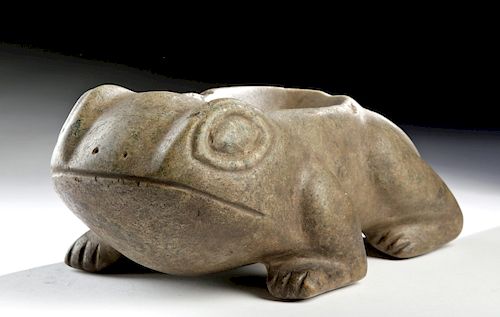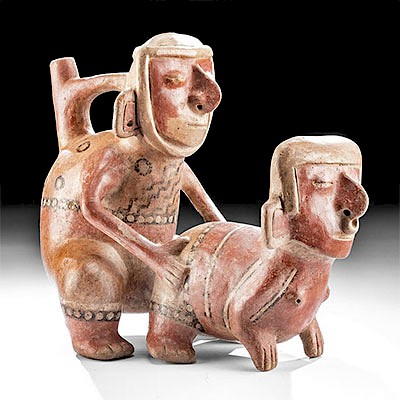Moche Greenstone Frog Mortar
Lot 22a
About Seller
Artemis Fine Arts
686 S Taylor Ave, Ste 106
Louisville, CO 80027
United States
Selling antiquities, ancient and ethnographic art online since 1993, Artemis Gallery specializes in Classical Antiquities (Egyptian, Greek, Roman, Near Eastern), Asian, Pre-Columbian, African / Tribal / Oceanographic art. Our extensive inventory includes pottery, stone, metal, wood, glass and textil...Read more
Estimate:
$5,000 - $7,500
Absentee vs Live bid
Two ways to bid:
- Leave a max absentee bid and the platform will bid on your behalf up to your maximum bid during the live auction.
- Bid live during the auction and your bids will be submitted real-time to the auctioneer.
Bid Increments
| Price | Bid Increment |
|---|---|
| $0 | $25 |
| $300 | $50 |
| $1,000 | $100 |
| $2,000 | $250 |
| $5,000 | $500 |
| $10,000 | $1,000 |
| $20,000 | $2,500 |
| $50,000 | $5,000 |
| $100,000 | $10,000 |
| $200,000 | $20,000 |
About Auction
By Artemis Fine Arts
Jan 30, 2020
Set Reminder
2020-01-30 10:00:00
2020-01-30 10:00:00
America/New_York
Bidsquare
Bidsquare : Pre-Columbian | Tribal | Ethnographic
https://www.bidsquare.com/auctions/artemis-gallery/pre-columbian-tribal-ethnographic-4830
Featuring ancient and ethnographic art from around the world, including Pre-Columbian, Native American, African / Tribal, Oceanic, Ethnographic, Spanish Colonial, Fossils, Fine Art, much more. Artemis Fine Arts info@artemisfinearts.com
Featuring ancient and ethnographic art from around the world, including Pre-Columbian, Native American, African / Tribal, Oceanic, Ethnographic, Spanish Colonial, Fossils, Fine Art, much more. Artemis Fine Arts info@artemisfinearts.com
- Lot Description
Pre-Columbian, North Coast Peru, Moche Culture, ca. 100 to 700 CE. A handsome, heavy greenstone mortar in the form of a crouching frog, his back hollowed out to create a shallow, ovoid bowl for grinding. His legs and feet are nicely delineated in relief against the body, forming a sturdy base for the vessel. The eyes are massive, deeply incised and with thick outlines around them, giving them a bulging, lifelike appearance. The mouth is incised to appear closed. Size: 8.7" L x 5.1" W x 3.75" H (22.1 cm x 13 cm x 9.5 cm)
Toads and frogs are common iconography in the pre-Columbian New World, where their tadpole-to-land-animal life cycle resulted in them becoming symbols of rebirth. Some toads were also known for their hallucinogenic secretions and toad remains are commonly found in tombs. The Jesuit Bernabe Cobo, in his "Historia del Nuevo Mundo" written in the early 1600s, recorded that the common toad (in Quechua, the "hampatu") was venerated by local people in the Andes. He noted its connection to water, and Incan art (a successor of the Moche), such as the stone of Sayhuite, depicts toads in water basins and near other symbols of water. From the life-giving properties of water, it seems likely that toads were also associated with fertility.
Provenance: private southwestern Pennsylvania, USA collection, before 1990
All items legal to buy/sell under U.S. Statute covering cultural patrimony Code 2600, CHAPTER 14, and are guaranteed to be as described or your money back.
A Certificate of Authenticity will accompany all winning bids.
We ship worldwide and handle all shipping in-house for your convenience.
#146299Intact, with small chips and nicks from surface, especially from rim of bowl. Rich, deep patina and nicely preserved form.Condition
- Shipping Info
-
All shipping is handled in-house for your convenience. Your invoice from Artemis Gallery will include shipping calculation instructions. If in doubt, please inquire BEFORE bidding for estimated shipping costs for individual items.
-
- Buyer's Premium



 EUR
EUR CAD
CAD AUD
AUD GBP
GBP MXN
MXN HKD
HKD CNY
CNY MYR
MYR SEK
SEK SGD
SGD CHF
CHF THB
THB
















